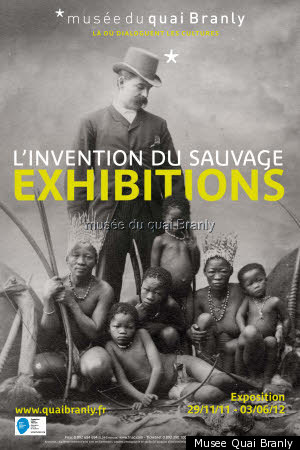Paris--
Remember those pictures of the African disk-mouth people in the 1950s National Geographics or the alleged Amazonian cannibals with what looked like pencils piercing their noses? This winter they're at the top of the charts at the relatively new and clearly sexiest of museums, the Musee de Quai Branly, the temple to "ethnographic art" built by France's star architect Jean Nouvel a few years back. The expo is called "Human Zoo: The Invention of the Savage." It's all about how anthropologists, intellectuals and circus entrepreneurs who teamed up with the new art of photography 150 years ago to invent the Western idea of "savage" people.
The show's curators say that some 35,000 men, women and children were brought to Europe and America between 1800 and 1950, then paraded before white Europeans and Americans in what were essentially "human zoos" of people presented as "exotics," "freaks" and "monsters."
General curator--and former soccer star--Lilian Thuram spent two years sorting through flyers, postcards, magazines, books and films. "They explain the racist prejudices, with their hierarchies and contempt, that live on in our society," Thuram says. "When I go into schools to talk about racism, children still do not know that there are not several different races, but just one species: Homo sapiens. How many people still think, consciously or unconsciously, that the color of a person's skin determines their qualities or faults? Do Blacks run faster? Do Whites swim faster?"

The whole notion of creating these "human zoos," says scientific curator Pascal Blanchard was to create a clear divide--and hierarchy--between so-called superior and inferior human beings. To bring that line between the "normal" and the abnormal front and center, scientific claims became married to pop entertainment. None were more famous or commercially successful than the glorious Venus Hottentot.
Born sometime before 1790 in eastern South Africa, she was given the name Sarah Baartman by the Dutch farmer-raiders who took her as a slave. But one of her captors, fascinated by the young woman's remarkable physical features--including enormous hips and elongated labia typical of the Khoi people along the Gamtoos River--decided she was worth more as a show creature in England for a public fascinated in the new "scientific" study of race. So he sold her to a Scottish entrepreneur. Sarah Baartman quickly became a major ticket draw earning her promoters huge profits until they re-sold her to a Parisian animal trainer who later turned her over to the Museum of Natural History, where after her death in 1815 her brain and sexual organs were preserved and kept on display until 1974. Following a request by Nelson Mandela that her remains be returned to her homeland in the Gamboos Valley--and following fierce debate in the French National Assembly--what was left of the "Hottentot Venus" was buried in 2002.

Zulus, Aboriginals, Mexican Aztecs, pygmies, even Indian snake charmers and Japanese acrobats found themselves paraded before Western footlights or poked and probed by "scientific investigators" set on codifying the difference between these "monster" throwbacks and their white masters in the great colonial empires--of which France was then a key global player.
Writes co-curator Janette Snoep in a foreword to the exhibit, "By giving them a name, a life and a history, we free these people from the shackles in which they were once held, restoring dignity to individuals who suddenly found themselves thrust on stage in front of a curious crowd simply because they were considered different."

Yet despite the high-minded intentions of the Quai Branly curators and despite the show's enormous popularity, it still takes no more than a few hours wandering around today's Paris to sniff out the residue of the past, not least in my own very politically correct Latin Quarter neighborhood where you can find on the Place de la Contrascarpe a giant exterior painted poster entitled, "Au Negre Joyeux" (or The Happy Nigger), depicting a happy black servant presenting a silver pot of bubbling chocolate to his very proper mistress.
